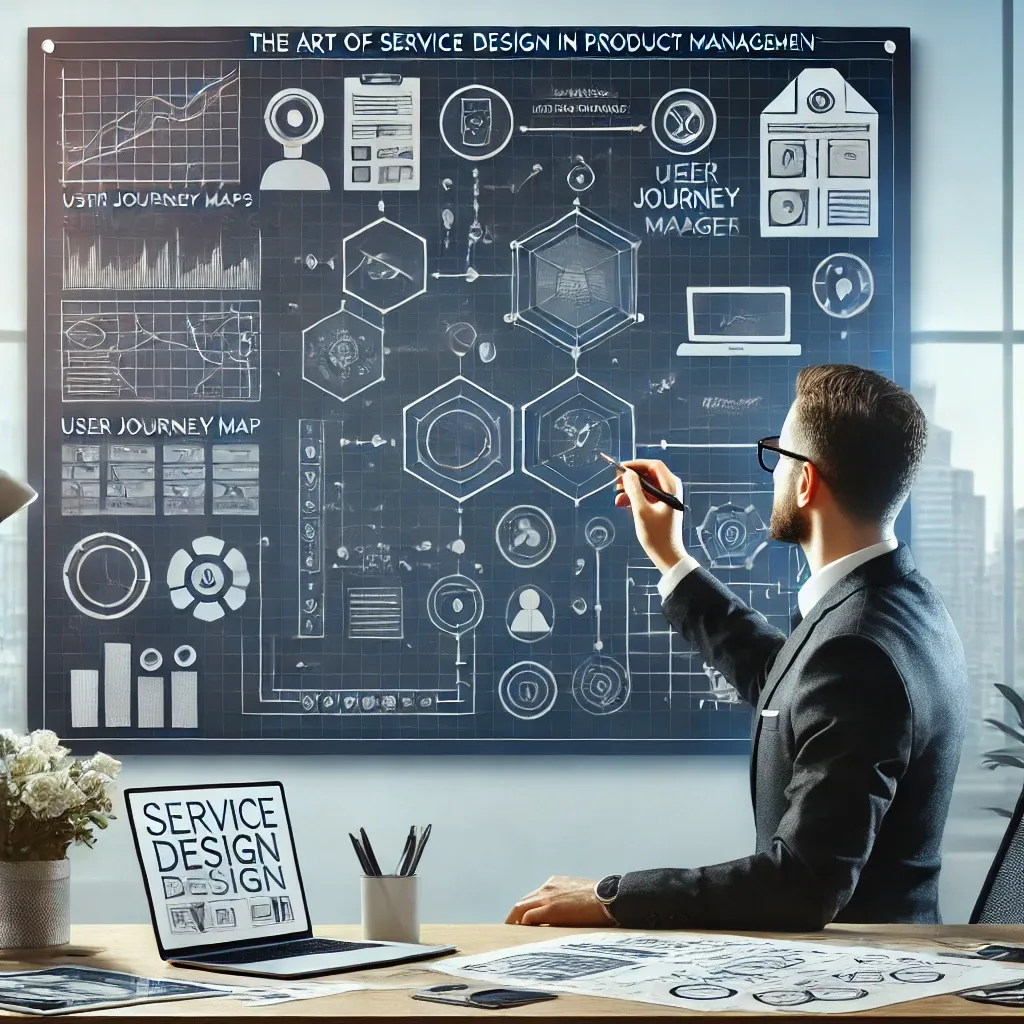Introduction to Product Service Management
The concept of Product Service Management (PSM) plays a pivotal role in bridging the gap between product development and customer satisfaction. PSM is defined as the process of creating, prioritizing, and delivering services associated with a product to meet customer needs effectively. This function not only focuses on the product itself but also emphasizes the services that enhance the overall customer experience, making it a critical aspect of modern project management practices [12].
Importance of Service Design in Product Management
Service design is integral to product management as it ensures that the services surrounding a product are thoughtfully crafted to enhance user experience and satisfaction. By applying service design principles, product managers can create a seamless interaction between the customer and the product, leading to improved customer loyalty and retention. The alignment of product strategy with customer needs is essential for maximizing impact and achieving business goals [2][7]. Moreover, effective service design can lead to continuous improvements based on user feedback, which is vital for maintaining high-quality standards and operational efficiency [5][10].
Overview of the Blog’s Structure
This blog will delve into the art of service design within the context of product management, exploring various principles and strategies that can be employed to enhance product offerings. Readers can expect to find:
- Detailed discussions on the key components of product service management and how they relate to project management.
- Insights into best practices for integrating service design into product development processes.
- Case studies and examples that illustrate successful implementations of service design in product management.
- Practical tips and tools for service designers and product managers to collaborate effectively and drive innovation.
By the end of this blog, readers will gain a comprehensive understanding of how product service management and service design can work hand-in-hand to create exceptional product experiences that resonate with customers and drive business success.
Understanding Service Design
Service design is a strategic approach that focuses on creating and improving services to enhance the overall user experience. It encompasses a holistic view of how services are delivered, ensuring that they meet the needs and expectations of users while also being efficient and effective for service providers. Here are some key points to consider:
Definition of Service Design and Its Core Principles
Service design is defined as a human-centered approach aimed at creating services that are useful, usable, desirable, efficient, and effective. It emphasizes understanding user needs and the interactions that occur throughout the service journey. The core principles of service design include:
- User-Centric: Services must be designed around the users, ensuring that their needs and experiences are prioritized [5].
- Co-Creative: Involving all relevant stakeholders in the design process fosters collaboration and innovation [8].
- Iterative: Service design is an ongoing process that involves continuous testing and refinement based on user feedback [10].
- Holistic: It considers the entire service ecosystem, including all touchpoints and interactions, rather than focusing on isolated components [13].
- Value-Driven: The ultimate goal is to create value for both users and service providers, enhancing the overall service experience [10].
The Difference Between Service Design and Product Design
While service design and product design are both essential in the realm of user-centered design, they focus on different aspects of the value proposition:
- Service Design: This approach is broad and holistic, concentrating on the overall experience of the service, including user interactions, touchpoints, and the service environment. It aims to improve the service delivery process and ensure that it aligns with user expectations [2][3].
- Product Design: In contrast, product design is more focused on creating tangible solutions, such as physical products or digital applications. It emphasizes usability, functionality, and aesthetics, ensuring that the product meets user needs effectively [4][15].
Understanding these distinctions is crucial for product managers and service designers as they work together to enhance product offerings through effective service design principles.
The Role of User Experience (UX) in Service Design
User experience (UX) plays a pivotal role in service design, as both fields share a common goal: to provide a top-quality experience for users. However, they differ in their focus:
- Service Design: It goes beyond individual touchpoints and interactions, examining how these elements are interconnected and how users navigate through the service. Service designers consider the entire journey, ensuring that each interaction contributes positively to the overall experience [12][13].
- UX Design: This discipline primarily focuses on improving the user’s experience with a specific product, often digital in nature, such as apps or websites. UX design aims to create intuitive and engaging interfaces that facilitate user interaction with the product [12].
Incorporating UX principles into service design allows for a more comprehensive understanding of user needs and behaviors, ultimately leading to more effective and satisfying service experiences. By recognizing the interplay between service design and UX, product managers can better align their offerings with user expectations, enhancing both product and service quality.
Key Principles of Service Design in Product Management
The integration of service design principles is crucial for creating offerings that resonate with users and meet their needs effectively. Here are the essential principles that can enhance product offerings:
- User-Centered Approach: At the heart of service design is a deep understanding of user needs and pain points. This principle emphasizes the importance of placing the consumer at the center of the design process. By actively seeking user input and feedback, product managers can refine their offerings to ensure they align with the evolving expectations of their target audience. This approach not only enhances user satisfaction but also fosters loyalty and engagement with the product [2][3].
- Co-Creation: Involving stakeholders in the design process is vital for successful service design. This principle advocates for collaboration among various parties, including customers, employees, and partners. By engaging these stakeholders, organizations can gather diverse insights and perspectives that contribute to more innovative and effective service solutions. Co-creation helps ensure that the final product not only meets user needs but also addresses the operational capabilities of the service provider [4][14].
- Iterative Design: The importance of prototyping and user feedback cannot be overstated in service design. This principle encourages a cycle of continuous improvement, where initial designs are tested and refined based on user interactions and feedback. By adopting an iterative approach, product managers can identify potential issues early in the development process and make necessary adjustments, ultimately leading to a more polished and user-friendly product [8][10].
- Holistic Perspective: Service design requires a comprehensive view of the entire service ecosystem. This principle involves considering all touchpoints in the user journey, from initial contact through to post-service support. By understanding how different elements of the service interact and affect the user experience, product managers can create a seamless and cohesive service offering that delivers value at every stage of the customer journey [9][10].
Incorporating these key principles of service design into product management not only enhances the quality of the offerings but also ensures that they are tailored to meet the specific needs of users. By focusing on user-centered design, fostering collaboration, embracing iterative processes, and maintaining a holistic view, product managers can significantly improve their service offerings and drive greater business value.
Integrating Service Design into Product Development
Integrating service design practices can significantly enhance product offerings and improve user experiences. This section explores how service design principles can be effectively woven into the product development lifecycle, ensuring that both service designers and product managers work in harmony to create user-centric solutions.
Aligning Service Design with Product Strategy
To successfully integrate service design into product development, it is crucial to align service design principles with the overarching product strategy. This alignment ensures that the services offered not only meet user needs but also support the strategic goals of the organization. Key considerations include:
- Understanding User Needs: Service design emphasizes a user-centric approach, which involves gathering qualitative insights about users’ thoughts, feelings, and goals. This understanding should inform product strategy, ensuring that the services developed resonate with the target audience [11].
- Defining Service Purpose: Each service should have a clear purpose that aligns with customer demand and the company’s capacity to deliver. This clarity helps in prioritizing features and functionalities that enhance the overall product offering [2][10].
Phases of Integration
The integration of service design into product development can be broken down into several key phases:
- Research: This initial phase involves conducting thorough user research to gather insights about user experiences and expectations. Service designers can employ qualitative research methods to understand the diverse perspectives of users, which will inform subsequent phases [12].
- Ideation: In this phase, cross-functional teams, including service designers and product managers, collaborate to brainstorm innovative solutions. Utilizing powerful storytelling can help convey user needs and aspirations, ensuring that the ideas generated are grounded in real user experiences [7].
- Design: During the design phase, service design principles guide the creation of user journeys and touchpoints. This holistic approach ensures that all interactions are seamless and connected, enhancing the overall user experience [3][10].
- Testing: Prototyping and testing are critical to validate the service design concepts. Engaging users in this phase allows for feedback that can refine the product before full-scale implementation. This iterative process is essential for ensuring that the final product meets user expectations [11].
- Implementation: Finally, the implementation phase requires careful coordination between service designers and product managers to ensure that the service is delivered effectively. This collaboration is vital for addressing any challenges that arise during the rollout and for making necessary adjustments based on user feedback [13].
Cross-Functional Collaboration
Successful integration of service design into product development hinges on effective cross-functional collaboration. Service designers and product managers must work closely together throughout the entire lifecycle to ensure that both the service and product aspects are aligned. This collaboration can be fostered through:
- Regular Communication: Establishing open lines of communication between teams helps in sharing insights and aligning goals. Regular meetings can facilitate discussions on user feedback and design iterations [14].
- Shared Goals: Defining common objectives that encompass both service and product outcomes encourages teamwork and a unified approach to problem-solving [15].
- Collaborative Tools: Utilizing collaborative tools and platforms can streamline workflows and enhance transparency, making it easier for teams to work together effectively [6].
By integrating service design principles into the product development lifecycle, organizations can create offerings that not only meet user needs but also drive business success. This approach not only enhances the user experience but also fosters a culture of innovation and collaboration within product teams.
Tools and Techniques for Effective Service Design
Effective service design is essential for creating offerings that resonate with users and meet business objectives. By employing a variety of tools and techniques, service designers and product managers can enhance their service design processes, ensuring that they are user-centered and efficient. Here are some key tools and techniques that can significantly improve service design in product management:
- User Journey Mapping: This technique involves visualizing the entire customer experience, from initial contact through to the final interaction with the service. By mapping out each step of the user journey, teams can identify pain points, opportunities for improvement, and moments of delight. This holistic view helps in understanding how users interact with the service and informs design decisions that enhance overall satisfaction [3][7].
- Personas: Creating user personas is a powerful method for developing user archetypes that represent different segments of the target audience. These personas help guide design decisions by providing insights into user needs, behaviors, and motivations. By keeping these personas in mind throughout the design process, teams can ensure that their services are tailored to meet the specific requirements of their users, ultimately leading to a more effective service offering [3][4].
- Service Blueprints: Service blueprints are detailed visual representations of the service delivery process, outlining all touchpoints, processes, and stakeholders involved. This tool helps teams understand the complexities of service interactions and ensures that all aspects of the service are considered during the design phase. By detailing the service delivery process, teams can identify areas for improvement and streamline operations, enhancing the overall user experience [12][4].
- Prototyping Tools: Utilizing prototyping tools and methodologies is crucial for testing designs before full-scale implementation. These tools allow teams to create mock-ups of their services, enabling them to gather feedback from users and stakeholders early in the design process. This iterative approach helps in refining ideas and ensuring that the final product aligns with user expectations and needs [5][10].
By integrating these tools and techniques into the service design process, product managers and service designers can create more effective, user-centered services that not only meet business goals but also enhance the overall customer experience. Emphasizing a structured approach to service design will ultimately lead to more innovative and successful product offerings.
Challenges in Product Service Management
Implementing service design practices within product management can significantly enhance product offerings, but it is not without its challenges. Here are some common hurdles that service designers and product managers may encounter:
- Resistance to Change Within Organizations: One of the most significant barriers to effective service design is the inherent resistance to change that often exists within organizations. Many stakeholders may be accustomed to traditional methods and may be hesitant to adopt new practices that service design entails. This resistance can stem from a lack of understanding of service design principles or fear of the unknown, which can hinder the implementation process and limit the potential benefits of service design initiatives [2][9].
- Balancing Short-Term Product Goals with Long-Term Service Design Objectives: Product managers frequently face the challenge of aligning immediate product goals with the broader, long-term objectives of service design. This balancing act can create tension, as the urgency of meeting short-term targets may overshadow the need for a comprehensive service design approach that focuses on enhancing customer experiences over time. Striking the right balance is crucial for ensuring that service design efforts are not only effective but also sustainable [3][10].
- Resource Allocation and Budget Constraints: Effective service design often requires significant investment in terms of time, personnel, and financial resources. However, many organizations operate under tight budget constraints, which can limit the ability to allocate sufficient resources to service design initiatives. This challenge is compounded by the need for cross-functional collaboration, as service design typically involves multiple departments and stakeholders. Without adequate resources, the implementation of service design practices may be compromised, leading to suboptimal outcomes [6][12].
By recognizing and addressing these challenges, service designers and product managers can better navigate the complexities of product service management and leverage service design principles to enhance their product offerings effectively.
Future Trends in Product Service Management
As we look towards the future of product service management, several key trends are emerging that will significantly influence how service design is approached within product management. These trends not only reflect the evolving landscape of technology and consumer expectations but also highlight the importance of ethical practices and sustainability. Here are the critical trends shaping the future of service design in product management:
- The Rise of AI and Machine Learning in Service Personalization: Artificial intelligence (AI) and machine learning are becoming integral to service design, enabling product managers to create highly personalized experiences for users. By leveraging AI, service designers can analyze vast amounts of data to understand customer preferences and behaviors, allowing for tailored service offerings that enhance user satisfaction and engagement. This trend emphasizes the need for product managers to integrate AI tools into their workflows to optimize decision-making and improve service delivery [3][6].
- Sustainability and Ethical Considerations in Service Design: With an increasing focus on environmental responsibility, sustainability is becoming a central theme in service design. Product managers are now tasked with ensuring that their service offerings not only meet customer needs but also adhere to ethical practices and sustainability goals. This includes considering the environmental impact of service delivery methods and materials used in product development. As consumers become more environmentally conscious, the demand for sustainable practices in service design will continue to grow, pushing product managers to innovate responsibly [10][14].
- The Growing Importance of Remote and Digital Service Design: The shift towards remote work and digital interactions has transformed how services are designed and delivered. Product managers must adapt to this new reality by developing services that are accessible and effective in a digital environment. This trend highlights the need for a robust digital service design strategy that prioritizes user experience, ensuring that services are intuitive and easy to navigate. As remote service delivery becomes the norm, product managers will need to embrace digital tools and platforms to enhance service accessibility and efficiency [8][10].
Conclusion
The integration of service design principles is not just beneficial; it is essential for enhancing product offerings and ensuring customer satisfaction. By focusing on the user experience and aligning services with customer needs, product managers can create more compelling and effective products. Here are the key takeaways:
- Importance of Service Design: Service design plays a crucial role in bridging the gap between customer expectations and product delivery. It enhances the overall customer experience, fosters loyalty, and drives growth by ensuring that products are not only functional but also resonate with users on a deeper level. This alignment is vital for maximizing profits and minimizing losses, as it directly impacts customer satisfaction and retention [2][6].
- Adopting a Service Design Mindset: Embracing a service design mindset encourages product managers and service designers to think holistically about the customer journey. This approach involves continuous improvements based on user feedback and a proactive stance in addressing challenges. By prioritizing the service aspects of products, teams can innovate and adapt to the ever-evolving market demands [1][7][9].
- Engagement with the Community: We encourage you to engage with fellow service designers and product managers. Share your experiences, insights, and challenges in applying service design principles. This collaborative spirit not only enriches your own understanding but also contributes to the collective knowledge of the community, fostering innovation and excellence in product service management [4][8].
By implementing these principles, you can significantly enhance your product offerings and create memorable experiences for your customers. Let’s continue to explore, innovate, and elevate the standards of product service management together.
Find out more about Shaun Stoltz https://www.shaunstoltz.com/about/.
This post was written by an AI and reviewed/edited by a human.



